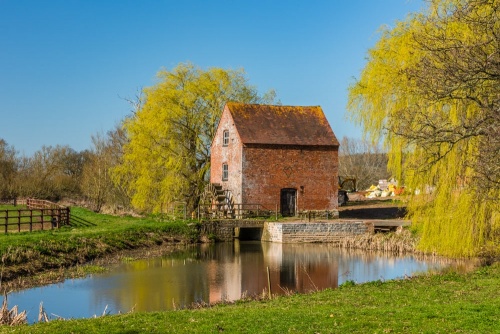
A 17th-century watermill stands in rural splendour on the River Leadon, outside Hartpury. The mill probably occupies the same site as a series of mills dating back to at least the 11th century.
The mill stands on private property and is not open to the public, but we've included it in our gazetteer because it is so easy to see from the road and it forms part of an exceptional collection of historic buildings at Hartpury that includes the 11th-century parish church, a 14th-century barn, a Victorian bee shelter, a Dominican Chapel, and a 19th-century manor house.
History
The Domesday Book of 1086 records the lands of the extensive estates held by the Abbey of St Peter, Gloucester. Under the entry for the Dudstone Hundred it mentions the Barton estate, and part of that estate is Hartpury, recorded as 'Morwent'.
Part of the estate is a watermill, with an income of 5 shillings. Is this the first mill on the River Leadson at Hartpury? There is no way of knowing for sure, but it seems very possible since we know that the abbey owned a mill here in the 13th century.
An inventory of abbey lands in 1267 records '2 watermills in one house' (i.e. a mill with two mill wheels). The mill had an estimated income of 5 marks per year.

The Mill
As for the mill we see today, we do not know exactly when it was built, but it is shown on a map of Hartpury estate in 1669.
In 1770 it was recorded as three corn mills (three separate mill wheels) under the same roof. In 1919 it had a pair of undershot mill wheels driving three pairs of grindstones.
The mill we see today has just one wheel, on the south side of the mill building, facing the millpond. During the medieval period there would have been a wharf beside the mill, accessed by ships sailing up and down the River Severn.
The red-brick building that houses the mill is largely 19th century, in Flemish-bond style, and stands 2 and a half storeys high. The single ill wheel is of undershot design and is made of iron with timber paddles.
Viewing the mill from the road, looking across the peaceful mill pond, is one of the most idyllic sights you can imagine. It is perhaps not worth making a special trip to view the mill on its own, but it is well worth a visit to view as part of exploring all the historic buildings surrounding the church.
Getting There
The church and bee shelter are signposted off the A417 in Hartpury village. Simply follow the brown tourist signs and park at the church. From there, walk down Park Road, with the tithe barn on your left, and you will see the watermill ahead on your right through a band of trees.
Walk past the private drive to Hartpury Mill, with a hedge and a stand of trees screening the mill, to the end of the hedge. You will have clear views across the millpond to the mill. From the church to the mill is no more than five minutes very easy walk.
About Hartpury Watermill
Address: Park Road,
Hartpury,
Gloucestershire,
England, GL18 1HH
Attraction Type: Historic Building - Watermill
Location: On private land, just west of St Mary's Church. Very good views from the road.
Website: Hartpury Watermill
Location
map
OS: SO777236
Photo Credit: David Ross and Britain Express
HERITAGE
 We've 'tagged' this attraction information to help you find related historic attractions and learn more about major time periods mentioned.
We've 'tagged' this attraction information to help you find related historic attractions and learn more about major time periods mentioned.
Find other attractions tagged with:
NEARBY HISTORIC ATTRACTIONS
Heritage Rated from 1- 5 (low to exceptional) on historic interest
Hartpury Tithe Barn - 0.1 miles (Historic Building) ![]()
Hartpury Old Dominican Chapel - 0.2 miles (Historic Church) ![]()
Hartpury, St Mary's Church - 0.2 miles (Historic Church) ![]()
Hartpury Bee Shelter - 0.2 miles (Historic Building) ![]()
Hartpury Orchard Centre - 1.2 miles (Countryside) ![]()
Corse, St Margaret Church - 1.9 miles (Historic Church) ![]()
Lassington, St Oswald's Church - 2.2 miles (Historic Church) ![]()
Ashleworth Tithe Barn - 2.7 miles (Historic Building) ![]()
Nearest Holiday Cottages to Hartpury Watermill:
Churcham, Gloucestershire
Sleeps: 4
Stay from: £450 - 1458
Churcham, Gloucestershire
Sleeps: 4
Stay from: £311 - 1022
More self catering near Hartpury Watermill



